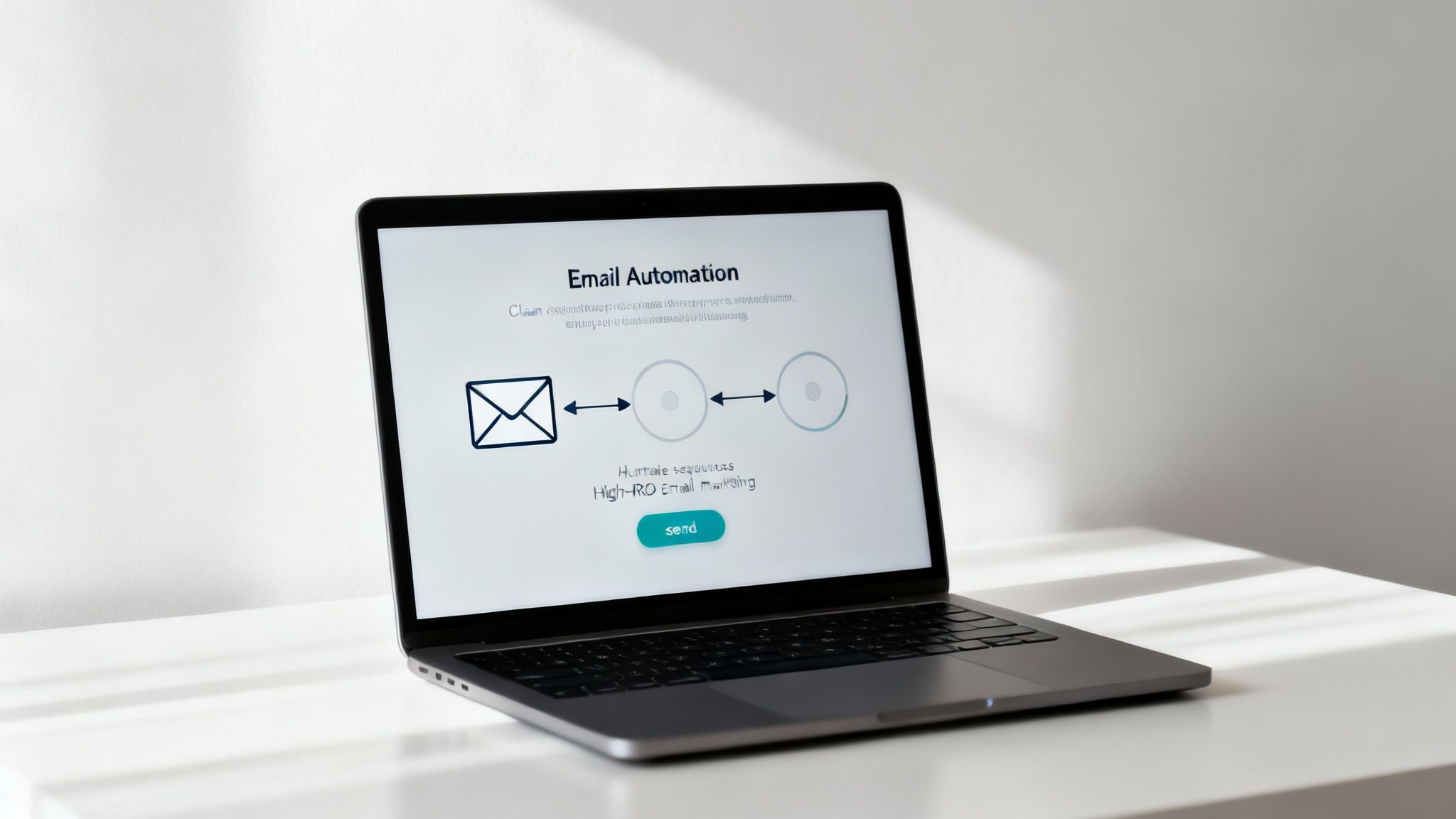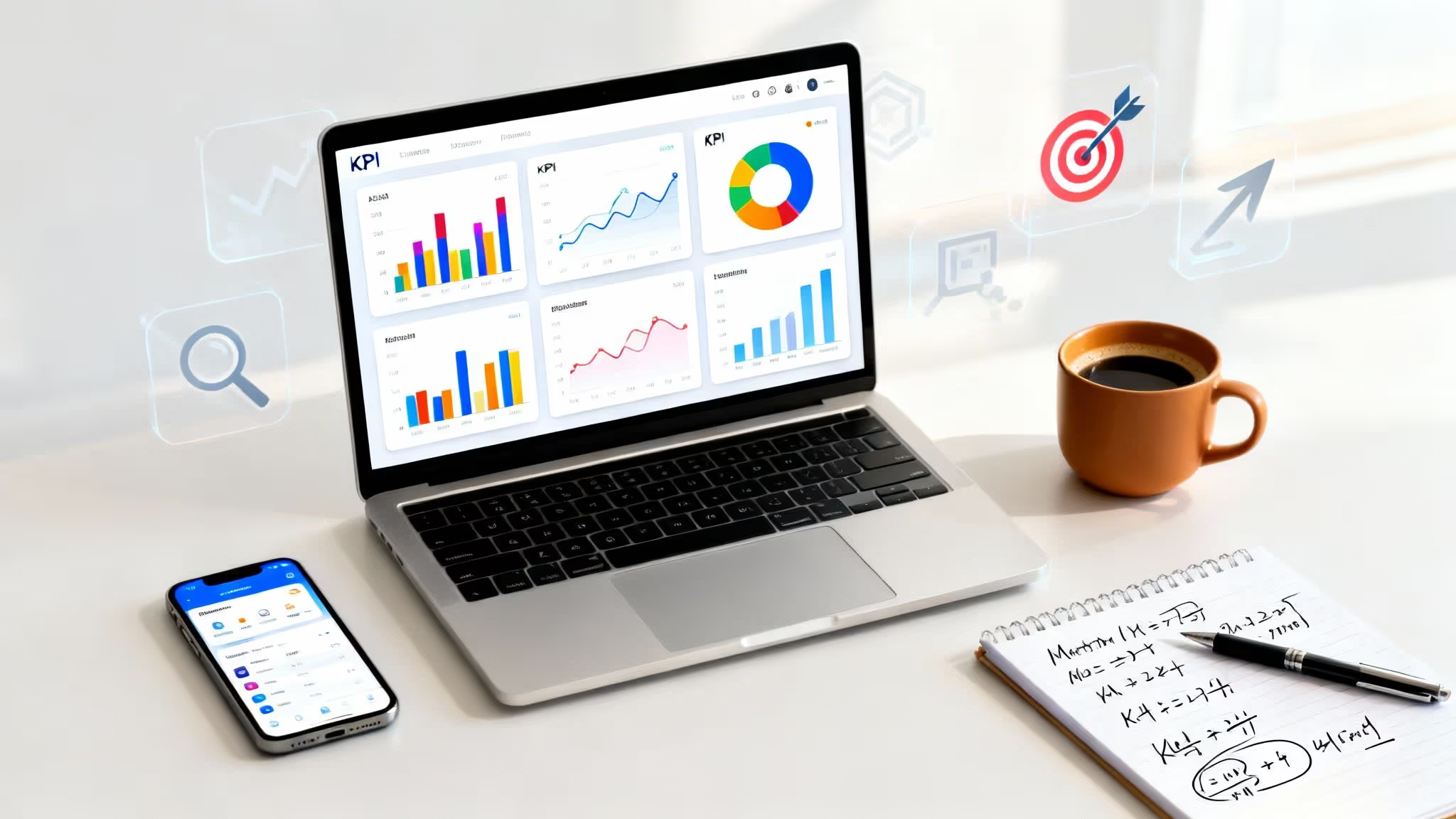In today's hyper-competitive IT landscape, simply offering excellent managed services isn't enough to guarantee growth. Standing out requires a deliberate, multi-faceted marketing approach that not only reaches potential clients but also builds trust and demonstrates unparalleled value. Many MSPs grapple with inconsistent lead flow, getting lost in a sea of competitors, or relying on outdated tactics that no longer resonate with modern B2B buyers.
The key to breaking this cycle lies in deploying a strategic mix of initiatives tailored to the unique challenges within the managed services industry. Success is no longer just about fixing problems; it's about becoming a strategic partner. This demands a marketing engine that consistently communicates your expertise, builds relationships, and positions your firm as an indispensable asset.
This guide moves beyond generic advice to provide a curated roundup of eight powerful and actionable MSP marketing strategies. Each is designed to help you build authority, generate high-quality leads, and create a sustainable engine for business growth. You won't find vague theories here but a practical playbook covering everything from hyper-targeted Account-Based Marketing (ABM) to leveraging local SEO for immediate client acquisition.
Whether you're looking to refine your current efforts or build a marketing plan from the ground up, these proven tactics will provide the blueprint for success. We will explore specific implementation steps and fresh perspectives to help you attract, engage, and convert the right clients for your managed services practice.
1. Content Marketing & Thought Leadership
Content marketing is one of the most powerful and sustainable msp marketing strategies available. It moves beyond direct sales pitches, focusing instead on creating and distributing valuable, relevant, and consistent content to attract and retain a clearly defined audience. For a Managed Service Provider, this means demonstrating your expertise and positioning your firm as a trusted authority—a thought leader—in the IT space. By addressing the specific pain points and technological challenges of your target clients, you build trust long before they even consider a purchase.
Why It’s a Top Strategy for MSPs
Potential clients are often researching solutions to complex IT problems like cybersecurity threats, cloud migration hurdles, or compliance requirements. Your content serves as their first point of contact. Providing clear, expert guidance through a blog post, whitepaper, or webinar establishes immediate credibility. This educational approach nurtures prospects, guiding them through their decision-making process and ensuring your MSP is top-of-mind when they are ready to invest in a solution.
Key Insight: Thought leadership isn’t about selling your services; it’s about proving your value. When you solve a small problem for free with a piece of content, prospects are more likely to trust you with their bigger, paid projects.
Actionable Implementation Steps
- Solve, Don't Sell: Center your content on your clients' biggest challenges. Create a blog post titled "5 Common HIPAA Compliance Gaps for Small Medical Practices" or a whitepaper on "A C-Level Guide to Phishing Prevention." This problem-first approach attracts a highly qualified audience.
- Establish a Niche: Don't try to be an expert on everything. If you specialize in serving legal firms, create content that addresses their unique technology and security needs, such as secure document management or e-discovery support.
- Repurpose Strategically: Maximize your efforts by turning one major piece of content into several smaller assets. A comprehensive webinar can be repurposed into a series of blog posts, a downloadable checklist, social media graphics, and short video clips.
- Use Data to Build Authority: Strengthen your arguments with current data and statistics. Citing industry reports on the average cost of a data breach, for example, adds weight and urgency to your cybersecurity content.
- Be Consistent: Create a documented content calendar and stick to it. Consistency is crucial for building an audience and signaling to search engines that your website is a reliable source of fresh information.
Leading MSPs excel at this by producing regular cybersecurity webinars and IT trend reports. By following their lead and applying these proven principles, you can transform your website from a simple brochure into a powerful lead-generation engine. For a deeper dive into creating an effective plan, you can explore these content marketing best practices.
2. Account-Based Marketing (ABM)
Account-Based Marketing (ABM) inverts the traditional marketing funnel. Instead of casting a wide net to capture as many leads as possible, ABM is one of the most precise msp marketing strategies, focusing your sales and marketing resources on a select group of high-value target accounts. For an MSP, this means identifying specific companies that fit your ideal customer profile and treating each one as its own market with personalized campaigns and outreach.

Why It’s a Top Strategy for MSPs
The MSP sales cycle is often long and involves multiple decision-makers, from the CTO to the CFO and CEO. ABM is uniquely suited for this environment because it orchestrates communication across the entire buying committee. By tailoring your messaging to address the specific business goals and technical pain points of a target company, you demonstrate a deep understanding of their needs, which can significantly shorten the sales cycle and increase deal size.
Key Insight: ABM isn’t about generating more leads; it’s about generating the right opportunities. By concentrating on accounts with the highest revenue potential, you ensure your marketing efforts deliver maximum ROI and align perfectly with sales objectives.
Actionable Implementation Steps
- Define Your Ideal Customer Profile (ICP): Analyze your best current clients to build a data-driven ICP based on firmographics like industry, company size, revenue, and technology stack. This profile becomes the blueprint for selecting your target accounts.
- Identify and Tier Your Target Accounts: Create a list of companies that match your ICP. Start small by selecting 5-10 "Tier 1" accounts to pilot your ABM program. These are your must-win clients where you'll deploy your most personalized campaigns.
- Coordinate Sales and Marketing Efforts: A successful ABM campaign requires a "smarketing" approach. Hold regular meetings between sales and marketing teams to align on target accounts, messaging, and outreach tactics, ensuring a seamless customer experience.
- Personalize Content and Outreach: Move beyond generic messaging. Create account-specific content like a case study on "How We Solved Cybersecurity Challenges for a Law Firm Like Yours" or run a LinkedIn ad campaign targeting employees at a specific company with a relevant whitepaper.
- Measure Account-Level Metrics: Shift your focus from vanity metrics like lead volume. Instead, track metrics that matter for ABM, such as account engagement, pipeline velocity, deal size, and close rate within your target accounts.
Tech giants have long used ABM to land enterprise deals by creating bespoke campaigns for individual clients. You can apply the same principles to target high-value local businesses, proving this is one of the most scalable msp marketing strategies available. To learn more about how this approach fits into a larger framework, explore these expert digital marketing strategies for managed service providers.
3. Partner Channel & Referral Marketing
Partnering with complementary businesses is one of the most scalable msp marketing strategies for generating high-quality, warm leads. This approach involves building a network of non-competing technology partners, vendors, and business consultants who serve the same target audience. By establishing formal referral programs and co-marketing initiatives, you can tap into an existing base of trusted client relationships, dramatically shortening your sales cycle and expanding your market reach.
Why It’s a Top Strategy for MSPs
Your ideal clients already have established relationships with other vendors, such as hardware suppliers, software developers, or specialized business consultants. A recommendation from one of these trusted advisors carries far more weight than a traditional advertisement. This strategy allows you to bypass cold outreach and connect directly with prospects who have a recognized need and a pre-established level of trust. It transforms your marketing from a solo effort into a collaborative, community-driven growth engine.
Key Insight: A strong partner channel isn't just a lead source; it's a validation of your expertise. When another respected company recommends your MSP, they are putting their own reputation on the line, providing a powerful endorsement that money can't buy.
Actionable Implementation Steps
- Identify Strategic Alliances: Look for partners whose services complement yours. A cybersecurity MSP could partner with a managed print provider, a VoIP phone system vendor, or a firm specializing in industry-specific compliance consulting (like HIPAA for healthcare).
- Formalize the Relationship: Don't rely on informal handshakes. Create a clear partner agreement that outlines the referral process, commission structure, and mutual expectations. Define what constitutes a qualified lead to avoid confusion.
- Enable Your Partners: Equip your partners to sell on your behalf. Provide them with co-branded marketing collateral, battle cards highlighting your unique value proposition, and training on how to spot opportunities for your services. Make it easy for them to refer business to you.
- Create a Tiered Program: Motivate top performers by creating a tiered partner program. Offer better commissions, increased marketing development funds (MDF), and more dedicated support for partners who consistently bring in high-value leads.
- Track Everything: Use a CRM or a dedicated Partner Relationship Management (PRM) platform to track referrals, manage communications, and measure the ROI of each partnership. This data is critical for refining your strategy and focusing on the most fruitful alliances.
Ecosystems like those built by major industry players demonstrate the power of this model, creating a network where partners actively support each other’s growth. By building your own strategic channel, you can turn your professional network into a predictable and highly effective pipeline for new business.
4. Email Marketing & Nurture Campaigns
Despite the rise of newer channels, email marketing remains one of the most effective and highest-ROI msp marketing strategies. It provides a direct line of communication to prospects and existing clients, allowing you to deliver targeted messages that guide them through the buyer's journey. For MSPs, this means systematically nurturing leads, educating them on complex IT solutions, and building lasting relationships that drive both new business and client retention.

Why It’s a Top Strategy for MSPs
The sales cycle for managed IT services can be long and complex. Prospects rarely decide after a single interaction. Email nurture campaigns automate the follow-up process, delivering valuable content like case studies, security alerts, and tech tips over time. This keeps your MSP top-of-mind and positions you as a helpful resource, building trust and credibility until the prospect is ready to engage with your sales team.
Key Insight: Effective email marketing is about delivering the right message to the right person at the right time. Automation allows you to scale this personalized communication, ensuring no lead falls through the cracks.
Actionable Implementation Steps
- Segment Your Lists: Group your contacts based on criteria like industry (healthcare, legal, finance), company size, or their stage in the sales funnel. This allows you to send highly relevant content that resonates with each specific audience.
- Create Automated Nurture Sequences: Use a marketing automation platform to build a 2-4 email sequence for new leads. The first email could deliver a requested resource, followed by emails that share a related case study, answer common questions, and finally, propose a consultation.
- Personalize for Impact: Go beyond using just the recipient's first name. Reference their industry or a specific challenge common to their business type. This level of personalization dramatically increases engagement rates.
- Focus on a Single, Clear CTA: Each email should have one clear goal. Whether it’s to "Download Our Cybersecurity Checklist," "Watch Our Webinar," or "Book a 15-Minute Assessment," make the next step obvious and compelling.
- Test and Optimize: Continuously test elements like subject lines, send times, and call-to-action buttons to improve your open and click-through rates. Monitor your list health by tracking unsubscribe rates and removing inactive contacts.
Platforms like Mailchimp and ActiveCampaign provide powerful tools for creating these campaigns. By implementing a systematic approach, you can turn your email list into a consistent source of qualified leads and strengthen relationships with current clients. To refine your approach, you can learn more about the best practices for email marketing campaigns and build a system that works for your MSP.
5. Local SEO & Google Business Profile Optimization
For MSPs serving specific geographic areas, local search engine optimization (SEO) is a fundamental requirement. This strategy focuses on making your MSP visible in local search results when potential clients search for terms like "IT support near me" or "managed services in [City Name]." It involves optimizing your website and online listings, particularly your Google Business Profile (GBP), to attract and convert prospects in your immediate service area.

Why It’s a Top Strategy for MSPs
When a local business faces a critical IT failure, they are not searching for a national provider; they are looking for a reliable, local expert who can respond quickly. A strong local SEO presence places your MSP directly in their path at the moment of highest need. By dominating local search results, you capture high-intent leads who value proximity and community presence, often leading to faster sales cycles. This is one of the most direct and cost-effective msp marketing strategies for driving qualified, location-based leads.
Key Insight: Local SEO is about proving your relevance to a specific community. When your Google Business Profile shows excellent reviews, a local address, and helpful updates, you signal to both Google and potential clients that you are the go-to IT authority in the area.
Actionable Implementation Steps
- Claim and Master Your GBP: Your Google Business Profile is your digital storefront. Fill out every section completely: services, service areas, hours, photos, and a detailed, keyword-rich business description. Use the Google Posts feature to share updates, offers, and blog articles.
- Ensure NAP Consistency: Your business Name, Address, and Phone number (NAP) must be identical across your website, GBP, and all online directories (like Yelp, BBB, and industry-specific sites). Inconsistencies can confuse search engines and harm your local ranking.
- Systematize Review Generation: Actively request reviews from satisfied clients. Positive reviews are a major local ranking factor and a powerful form of social proof. Respond to all reviews, both positive and negative, to show you are engaged and value client feedback.
- Create Location-Specific Service Pages: If you serve multiple cities or neighborhoods, create dedicated pages on your website for each one. Tailor the content to address local needs and include the location name in the URL, title tag, and headings.
- Build Local Citations and Links: Get your MSP listed in reputable local and industry-specific online directories. Pursue backlinks from other local businesses, chambers of commerce, or event sponsorships to build your local authority.
By optimizing for local search, you ensure your business appears when and where it matters most. For a comprehensive guide on building out your digital footprint, explore these tips for optimizing location pages for local SEO success.
6. LinkedIn B2B Networking & Paid Advertising
LinkedIn is the definitive professional social network, making it one of the most direct and effective msp marketing strategies for reaching business decision-makers. It operates on two powerful fronts: organic networking, which involves building relationships and authority through content and direct engagement, and paid advertising, which allows for hyper-targeted campaigns aimed at specific job titles, industries, and company sizes. For an MSP, LinkedIn provides unparalleled access to the IT directors, CFOs, and business owners who influence technology investments.
Why It’s a Top Strategy for MSPs
Unlike other social platforms, LinkedIn is a professional environment where users expect business-related content and outreach. This makes it the ideal place to discuss complex IT topics like cybersecurity, cloud infrastructure, and compliance. Your target audience is already on the platform, engaging in industry discussions and researching solutions. By establishing a strong presence, you can insert your MSP directly into these conversations, positioning your firm as a knowledgeable and accessible partner.
Key Insight: On LinkedIn, your personal profile and company page are not just resumes; they are dynamic sales and marketing assets. Consistently sharing valuable insights positions you as an expert, drawing qualified leads to you rather than you having to chase them.
Actionable Implementation Steps
- Optimize Your Digital Presence: Ensure your personal profile and company page are fully optimized. Use a professional headshot, a benefit-driven headline (e.g., "Helping Healthcare Practices Achieve HIPAA-Compliant IT"), and a detailed "About" section filled with relevant keywords.
- Share Value, Not Sales Pitches: Post consistently (2-3 times per week) with content that educates your audience. Share insights from your blog, comment on industry news, or create simple text-based posts that address a common client pain point. The goal is to build authority and trust.
- Leverage LinkedIn Ads for Precision Targeting: Use LinkedIn’s ad platform to run Lead Gen Form campaigns. Target users by job title (e.g., "IT Director," "Chief Financial Officer"), industry (e.g., "Financial Services," "Legal"), and company size to ensure your ad spend is only used on highly relevant prospects.
- Engage Before You Connect: Before sending a connection request, interact with a prospect's content. Like or comment thoughtfully on a post they shared. This "warm" approach significantly increases the chances of your connection request being accepted.
- Utilize Sales Navigator for Targeted Prospecting: For a more focused effort, invest in LinkedIn Sales Navigator. It provides advanced search filters, lead recommendations, and direct messaging capabilities (InMail) to streamline your outreach to key decision-makers.
By combining organic networking with targeted paid campaigns, MSPs can use LinkedIn to build a predictable pipeline of high-quality B2B leads. This dual approach ensures you are building long-term brand authority while simultaneously generating short-term opportunities.
7. Video Marketing & YouTube Channel Strategy
Video marketing has become one of the most compelling msp marketing strategies for engaging prospects and demonstrating technical expertise in a digestible format. It involves creating and distributing video content across platforms like YouTube to educate, build trust, and showcase solutions. For an MSP, this means transforming complex topics like cybersecurity protocols or cloud infrastructure into accessible visual content that builds brand authority and drives qualified leads.
Why It’s a Top Strategy for MSPs
Video is a powerful medium for simplifying intricate IT concepts. A well-produced video can explain a firewall configuration or demonstrate a phishing prevention tool far more effectively than a text-only article. It allows potential clients to see your team's expertise in action, fostering a human connection and building confidence. As the world's second-largest search engine, YouTube also enables your video content to attract prospects actively searching for solutions to their IT problems.
Key Insight: Prospects don't just want to be told you're an expert; they want to see it. A short tutorial or a client success story video provides tangible proof of your capabilities and helps differentiate your MSP in a crowded market.
Actionable Implementation Steps
- Start with High-Value Topics: Begin by creating videos that answer the most common questions you hear from prospects. Develop content like "How to Spot a Phishing Email in 30 Seconds," "A Quick Demo of Our Onboarding Process," or "Client Testimonial: How We Secured XYZ Law Firm."
- Optimize for Search: Treat your YouTube videos like blog posts. Use relevant keywords in your titles, descriptions, and tags. A title like "Cybersecurity Best Practices for Small Businesses" is more likely to be found than "Our New Security Video."
- Create Structured Playlists: Organize your videos into logical playlists on your YouTube channel. Create categories like "Cybersecurity Tips," "Client Success Stories," and "Product Tutorials" to help viewers easily find relevant content and encourage binge-watching.
- Include Clear Calls-to-Action (CTAs): Don't let a good video go to waste. Verbally mention and add links in your video description that guide viewers to the next step, such as "Download our free cybersecurity checklist" or "Schedule a free IT assessment."
- Promote Across All Channels: Embed your videos in relevant blog posts, share them in your email newsletters, and post clips to social media platforms like LinkedIn. This cross-promotion maximizes the reach and impact of each video you produce.
By applying these tactics, you can leverage video to build a powerful connection with your audience. To ensure your videos get discovered, you can dive into these best practices for YouTube SEO.
8. Event Marketing & Webinars
While digital marketing is essential, event marketing and webinars offer a powerful way to make direct, personal connections. This strategy involves hosting or participating in online and in-person events to generate leads, build relationships, and demonstrate expertise in real-time. For an MSP, this provides an invaluable platform for live Q&A sessions, product demonstrations, and face-to-face networking that digital channels alone cannot replicate.
Why It’s a Top Strategy for MSPs
Events cut through the digital noise, allowing you to engage directly with prospects who are actively seeking solutions. A well-executed webinar on a topic like "Navigating CMMC 2.0 Compliance" can attract dozens of qualified leads from the government contracting sector. Similarly, attending a local business expo or an industry conference puts you in the room with decision-makers, shortening the sales cycle and building tangible rapport.
Key Insight: Events and webinars transform your MSP from a name on a screen into a team of accessible experts. The trust built during a 45-minute webinar or a 5-minute conference conversation is often more impactful than months of passive content consumption.
Actionable Implementation Steps
- Start with Webinars: Before committing to costly in-person events, start with webinars. They are lower-cost, easier to organize, and provide a wealth of repurposable content. Focus on solving a specific, urgent problem for your target niche.
- Create Dedicated Landing Pages: For every webinar or event, build a unique landing page with all essential details: topic, speakers, date, time, and a clear registration form. This makes promotion easier and tracking sign-ups more effective.
- Promote Strategically: Begin promoting your webinar at least three to four weeks in advance through email marketing, social media, and a banner on your website. Send reminder emails to registrants to maximize attendance.
- Follow Up Immediately: The work isn't over when the event ends. Follow up with all attendees and registrants within 24 hours. Share a recording, a copy of the slides, and a clear call-to-action for those interested in a consultation.
- Repurpose Your Content: A single webinar can become a cornerstone of your marketing for weeks. Edit the recording into short video clips for social media, write a summary blog post, and create a downloadable guide from the key takeaways.
MSP Marketing Strategies: 8-Point Comparison
Integrating Your Strategies for Maximum Impact
Navigating the landscape of MSP marketing strategies can feel overwhelming. We've explored a powerful array of tactics, from establishing authority through content marketing to executing hyper-targeted account-based marketing (ABM) campaigns. We've seen how leveraging partner channels can create exponential growth, while sophisticated email nurture campaigns keep you top-of-mind. The digital storefront of local SEO, the networking power of LinkedIn, and the dynamic connection of video marketing and webinars are all indispensable.
However, the true catalyst for sustainable growth isn't deploying these strategies in isolation. The most successful Managed Service Providers understand that these are not individual checklist items but interconnected components of a single, high-performance marketing engine. Your efforts should create a self-reinforcing cycle where each strategy amplifies the others.
From Silos to Synergy: Building a Cohesive Marketing Engine
Imagine this integrated approach in action. A well-researched blog post on "Cybersecurity Trends for Law Firms" (Content Marketing) becomes the cornerstone of your entire campaign. This single piece of content can be:
- Atomized for Social Media: Key statistics and quotes are turned into engaging graphics and short-form videos for your LinkedIn networking efforts.
- Leveraged for Lead Nurturing: The full article is offered as a downloadable guide, feeding new leads into a targeted email nurture campaign designed specifically for legal professionals.
- Fuel for Events: The core topics are expanded upon in a live webinar, promoted to your email list and LinkedIn audience, capturing high-intent leads for your sales team.
- A Tool for Partnerships: You share this valuable resource with a complementary partner, such as a legal software vendor, providing value to their audience and generating warm referrals for your MSP.
This interconnectedness is the secret to maximizing your return on investment. Instead of running eight separate initiatives, you are running one cohesive, multi-channel campaign where every element works in concert. This approach ensures your brand message is consistent, your resources are used efficiently, and your target audience encounters your expertise at multiple touchpoints, building trust and accelerating the sales cycle.
Your Actionable Path Forward: Prioritize, Master, and Scale
The sheer number of effective MSP marketing strategies can seem overwhelming, but the path to implementation is straightforward. Don't try to tackle everything at once. Instead, focus on a methodical, data-driven approach.
- Assess and Prioritize: Begin by evaluating your current resources, in-house expertise, and most pressing business goals. If your immediate need is local client acquisition, mastering Local SEO and your Google Business Profile is a logical starting point. If you're targeting larger accounts, an ABM pilot program is your best bet.
- Execute and Master: Select one or two strategies that offer the most immediate impact for your MSP. Dedicate your focus to executing them flawlessly. Set clear KPIs, track performance meticulously, and refine your process until it becomes a predictable source of leads.
- Layer and Integrate: Once your initial strategies are delivering consistent results, you can begin to layer on complementary tactics. As you add new channels, constantly look for ways to integrate them with your existing processes to create powerful synergy.
Ultimately, mastering these MSP marketing strategies is about more than just generating leads; it's about building a predictable and scalable growth engine for your business. It’s the difference between reactive client acquisition and proactive market leadership. By moving from a scattered set of tactics to an integrated system, you transform marketing from a cost center into your company's most valuable asset for driving revenue and building long-term value.
Ready to build a powerful, integrated marketing and CRM framework that drives measurable growth for your MSP? Twelverays specializes in implementing data-driven MSP marketing strategies that deliver predictable results. Schedule a consultation with us today to discover how we can help you unlock your full growth potential.





